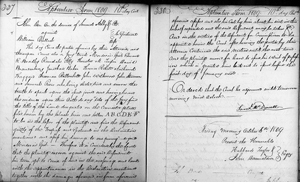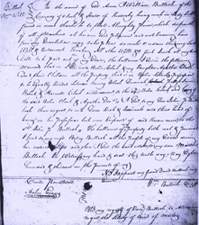John Thomas Bullock & Ancestors |
Click on a name to read more about the person, click on an arrow to follow that branch in the tree, or click for an Alphabetic List of all Names. |
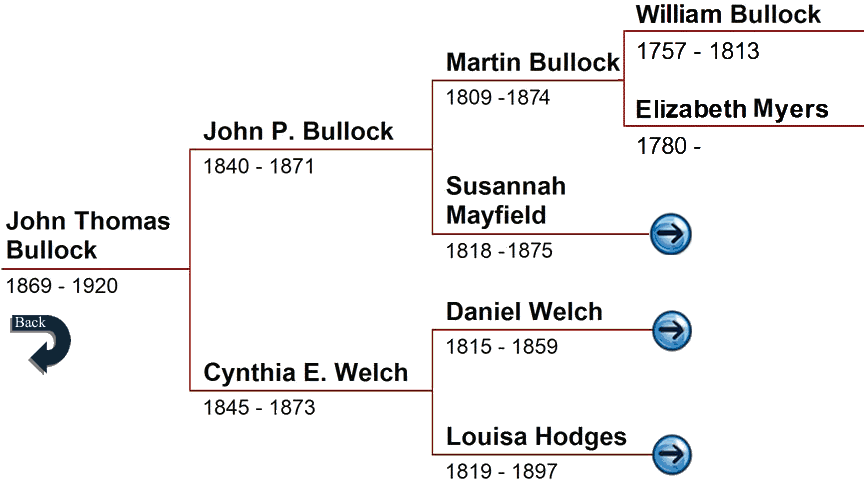 |
John Thomas Bullock was born November 1, 1869 in Illinois. He was the second child of John P. Bullock, about 29 and Cynthia Welch, about 24. John P. died in 1871. In 1872, Cynthia married John Stewart. Then, in 1873 Cynthia died. At this point, we can only speculate where John was during the next seven years. He may have stayed with his stepfather for a while, but was not with him in 1880. There were quite a few relatives living in Indiana and Illinois and he may have stayed with more than one. Here are those I consider prime candidates:
The next we know of him, he was nineteen. On May 2, 1889 John Thomas filed a request as a minor, for his father’s Civil War pension, apparently in Indiana. He also became a coal miner in Shelburn.
The Sullivan Democrat newspaper for Friday, July 10, 1891 states “John T. Bullock has been granted a pension amounting to $1,713.” On July 16, 1891, John jointly purchased a lot in Shelburn Indiana with Robert Bardsley for $100. It measured 100’ x 26’ and was near the railroad tracks in the middle of town. The Sullivan Democrat on Friday, July 31, 1891 reported “Lon Davis has sold his saloon to Robert Bardsley and John Bullock.” On November 4th, three days after John turned 21 and two months after his marriage, Robert sold him his half of the ownership for only $1.00. Robert was also a witness of the marriage. These real estate transactions apparently took some time to be finalized as they were reported in The Sullivan Democrat on Friday, December 11, 1891 as follows: “Real Estate Transfers For the week ending Dec. 9, 1891. Spence McGrew to John T. Bullock et al., part lot 32 in Shelburn. Robert Bardsley to Jno. T. Bullock et al., part lot 32 in Shelburn.”
John and Loretta had ten children - all born in Shelburn. In birth order, they were Edison John born on July 22, 1892, whose birth announcent in The Sullivan Union for Wednesday, July 27, 1892, read “John Bullock is happy it is a boy. John will commence immediately to train him in pugelism to go against Jas. Mannahan the Pennsylvania light weight who knocked out R. Bardsley the heavy weight in three rounds.” (Both Mannahan and Bardsley were friends of John’s.); Gerald Emerson on October 28, 1893, who died a month short of age 4; Aulberta (Bertie AKA Marie) on September 8, 1895; Stewart Wallace on September 12, 1897; William Jacob on August 4, 1900; Charles Samuel on May 29, 1902; Mary Louise. in 1905; Walter Bernhardt on May 6, 1907; ancestor James Russell Lowell born on October 4, 1909; and an unnamed female born on September 13, 1911 who had to have died young, as she is not listed on the January 5, 1920 census. Both Mary and James were born blind. Only Stewart and James had children to my knowledge. There is no explanation given, but The Sullivan Union reported on Wednesday, November 23, 1892, “John Bullock still sings, 'he is up with the angels now.’”
The next mention of John in the newspapers is four years later. The Sullivan Democrat for Friday, July 1, 1898 reported under the Shelburn section that “Mr. John Bullock and family, of Currysville, and Mrs. Isaacs, of Cincinnati, spent a few hours on the banks of the Wabash, fishing, last week.” The next month on August 12th and then again on September 9th, the newspaper reports him “on the sick list.” The 1900 census, dated June 6, shows that John was still a coal miner, but out of work for 4 months. On Wednesday, February 19, 1902 The Sullivan Union newspaper reported that “John Bullock and wife,of Currysville, have a sick child.” A few months later on Thursday, May 22, 1902, The Sullivan Democrat reports, “Wednesday's report of small pox finds John Bullock and Guss McCrosky as new victims of the disease.” A year later on August 27, 1903, it reports, “J. T. Bullock, of Currysville, had 82 chickens poisoned last week.” No other information was given onhis matter, so it is not clear exactly what happened. In January and February of 1906 there was a five-week revival meeting held in Shelburn. The Sullivan Democrat reported on Thursday, February 15th, “Last Monday night was the close of the greatest revival meeting ever held in the Methodist church at this place. Over one hundred and fifty names added to the list of members of that church.” It is not certain if the entire Bullock family attended this meeting, but John and his 14 year old son Edison were listed among the 150 people who were converted. In her Autobiographical Sketch published in her book of poems, Roses and Violins, in 1958, John’s daughter Mary wrote, “My first public performance was at the age of seventeen months, when I sang a solo from my father’s pulpit.” This would be sometime around 1905-06, which indicates that his conversion led him to become a preacher. This is supported by the fact that The Sullivan Union newspaper for Wednesday, October 14, 1908, writes an obituary for “Mrs. Bosstick, the wife of Perry Bosstick,” who happens to be John’s first cousin. At the end of the article it states “Mrs. Bosstick was buried Monday at the Davis graveyard, Rev. John Bullock officiating.” In March of 1910 he is again listed on the sick list. By 1910 John was an insurance agent living in Carlisle, while his wife and children were living in Shelburn. Although the May 2, 1910 US Census has him listed with his family in Curry Township, where Shelburn is located, there are several newspaper reports of him visiting them on the weekends up until August of 1910. There are only two newspaper accounts of him coming to Shelburn in 1911. The first was on March 9th stating “John T. Bullock of Carlisle was here Wednesday on business.” The second was on March 17th which states “John Bullock and wife were in Sullivan Saturday.” At the end of that month there is a letter for him, waiting for pick-up in the Sullivan Post Office. This seems to indicate that his visits to his family have become less frequent. The last mention of him as an insurance agent, in the newspapers, is in the month of November of 1912. Three different newspapers reported from November 8th to 14th that “The Prudential Insurance Company agents of the Vincennes District held their annual business meeting in Carlisle . . ” It went on to explain that “The agent who writes the largest amount of insurance during the eight weeks previous to the time of the meeting is allowed to select any town in his territory for the meeting. This year John T. Bullock, a former resident of Carlisle, but who now lives at Shelburn, was successful in doing more business than his fellow workers and Carlisle being in his territory he selected this place as the town where the meeting should be held.” Apparently he never went back to the family, but supported them until January of 1912, when he left for good and stopped the support. On December 4, 1913, Loretta filed for divorce stating her husband is living in San Diego, California. (Read her bio for the full story.) After much research, no documentation has been found to prove that he ever was in California. There is a listing in the 1914 Indianapolis City Directory for John T. Bullock, a foreman, living at 122 Butler Ave. But he is not listed in the 1915 directory. According to family friend, Maggie who wrote a history of the Bullocks that has since been lost, he ran horses for Pancho Villa. If this is true, it had to occur before 1920 when Villa retired. 1914 is right at the time that Villa was recruiting Americans to his cause. On John’s son Stewart's marriage license, dated June 2, 1919, it states that John is a miner in Dallas, Texas. On his wife Loretta’s 1920 census, dated January 5, 1920, she says she is widowed. But on his daughter Alberta’s marriage license application, dated July 9, 1920, she states her father is living in San Francisco, CA and working in real estate. There is no supporting evidence for any of these statements, so we may never know what really happened to John after he left his family. |
| ~< Back to Chart >~ |
John P. Bullock was born In Indiana about 1840, the second child of Martin Bullock, about 32 and Susannah Mayfield, about 22. The US Census dated September 23, 1850, shows the family living in Turman Township, Sullivan County, Indiana. Martin, a farmer, was 40 and Susan was 35. Besides John 10 years old, there were five other children (See Martin Bullock below for details). The next census, dated July 27, 1860, shows three more children, nine altogether. The Civil War began the following April. Three years later, on September 2, 1863, John about 23 years old married Cynthia Welch, about 18, in Sullivan County Indiana. Next year, on October 14, 1864, John was drafted into the Indiana 57th Infantry Regiment, Company F as a private. He may have been avoiding involvement in the war due to the supposed southern sympathies of his mother’s family (see Susannah Mayfield below). It was not long before John saw action. After the Atlanta campaign, Sherman detached the army of General George H. Thomas to deal with Confederate General John B. Hood who was invading Tennessee to cut off supply lines to Sherman’s army. Thomas had half of his army near Nashville and General John M. Schofield commanded the other half near Pulaski, about sixty miles to the south. John P. and his brother-in-law John H. Welch, drafted along with him, were certainly there with the 57th Indiana Regiment in early November under the command of Lieutenant Colonel Willis Blanch and Major John S. McGraw. Their’s was one of six regiments of the second brigade under Colonel John Q. Lane, which was one of three brigades of the second division under General George D. Wagner. Coming from the south, Hood saw an opportunity to engage and defeat Schofield before he could link up with Thomas in the north. During the last week in November, Schofield raced northward as Hood tried to outflank him as fighting occurred in Columbia/Duck River, Spring Hill and Thompson’s Station. Schofield’s forces reached Franklin at dawn on November 30th and quickly formed a defensive line in existing dirt walls on the southern edge of town. As it became late in the day, and the Union’s forces were in a strong defensive position, Schofield assumed there would be no battle that day. Unfortunately, he was wrong. (Mouse over map right for more info.) Those in Wagner’s three brigades were among the last to arrive, exhausted from the Spring hill fighting and having marched here without sleep. The 2nd and 3rd brigades were deployed a half mile south of the Union line as an advance guard in the unlikely event of an assault by the rebels. They totaled perhaps twelve hundred men, who now proceeded to dig in. John P. Bullock and John H. Welch were two of them. The 1st brigade was deployed on a nearby hill to watch for any advance of the Confederates. They soon saw the enemy approaching and retreated to the Union lines, but without notifying the other two brigades. Unfortunately the two brigades could not see the approaching army of twenty thousand soldiers due to trees and a house blocking their view until the last minute. They fired a volley and quickly started running north to the Union line. John P. and John H. were among those running for their lives with rebel soldiers all around them. Soldiers in the Union line could not fire for fear that they would shoot their own men. Union and Confederate soldiers poured into the Union works and close fighting ensued until the battle finally ended with a decisive Union victory. More than a thousand from Wagner’s 2nd and 3rd brigades were killed or captured. John P. and John H. were among those that made it to the Union lines - fewer than two hundred men.
John and Cynthia had a daughter, Lydia whose birth date is not known, who died in 1868. Their son, John Thomas Bullock was born on November 1, 1869 in Illinois. There is an 1870 census dated June 16, for a John and Catherine Bullock and their 8 month old son John T, living in the town of Sullivan, in Moultrie County, Illinois, that probably is them. John P. Bullock died in 1871 probably in Moultrie County. Perhaps he was injured in the war and died from complications. |
| ~< Back to Chart >~ |
Cynthia E. Welch was born about 1845, the fifth child of Daniel Welch, about 30 and Louisa Hodges, about 26 in Vigo Indiana. The US Census in Harrison Township, Vigo County, Indiana dated September 26, 1850 shows Daniel Welch 35 laborer, Louisa 31 and children Sally 14, John 12, James 9, William 6, “Sintha” 4 and Alley M. 1. Louisa’sbrother, Harden Hodges 26, a farmer, was living nearby with his wife and 3 young children. Cynthia’s father, Daniel, died in the Spring of 1859. A year later, the US census in Terre Haute, Indiana, dated June 6, 1860 shows Cynthia, 14 years old, living with Perry Pound 26, a wagon maker, |
| ~< Back to Chart >~ |
Martin Bullock was born about 1809. Although records do not exist, it is a most likely he was born in Winchester, Clark County, Kentucky, the only child born to William Bullock and his second wife Elizabeth Myers. Thomas Jefferson was President and Kentucy had been a state for 17 years. Martin was not even 5 years-old when his father died, leaving him in the care of his mother and 31 year-old half brother John P. Bullock. (The fact that Martin names his son John P., is strong support that William is his father.) Martin’s father leaves his remaining estate to his wife, and when she dies, to my son Martin. Nothing is known of Martin until he married Susannah Mayfield on December 28, 1835 in Illinois when he was about 26 years old (mouse over image right). In the Indianapolis Indiana Journal for Saturday, November 30,1839 in the Sullivan County Estrays section, it states: “Taken up by Martin Bullock, of Turman township, two estray Mares: one a Flea-bitten Gray, fifteen years old 14 ½ hands high; appraised at fifteen dollars: The other a Bay Mare, 3 years old last spring, black main and tail, star in the forehead, strip on her nose, branded on the near hip with the letters D. R., fourteen hands one inch high; appraised at $35, Oct. 5, before justice David Wilkins.” The US 1840 census shows a Martin Bullock in Sullivan County, Indiana. It lists two males under 5, one male 20-30 and one female 20-30. Apparently their first son did not survive until the next census. The US census dated September 23, 1850 in Turman Township, Sullivan County Indiana has Martin 40, a farmer and Susan 35. Children listed were John 10; Elizabeth 8; Mary 7; Chapman 5; Nancy 3; and Jasper 1. The next census, dated July 27, 1860 in the same place, lists their post office as Graysville. It shows three more children, Clifford 9; Persellia 8; and George 4, nine altogether. Martin apparently had a substantial farm that he purchased prior to 1860 as that years’ census, dated July 27th, shows him owning $560 in real estate and $250 personal estate. There is a deed on file in the Sullivan Recorder’s office dated February 19, 1864 where Martin purchased 56.6 acres from Calvin and Emily Fletcher for $366.92. On the 1870 US census, dated August 10 and 11th, they are still in Turman Township, but their post office is listed as Merom, which is 4½ miles south of Graysville on the Illinois border. This does not seem to indicate that they moved, since other people listed in Graysville in 1860 are also listed in Merom in 1870. This census has Martin Bullock 62, farmer; Susannah 53, keeping house; Jasper 21, farm hand; Clifford 18, farm hand; Percilla 17, at home; and George L. 14, works on farm. Susannah and two of her sons, Clifford and George, are listed as not being able to write. Martin’s real estate value was then $900 and personal was $375.
On Wednesday, December 31,1873, The Sullivan Democrat newspaper reported, “Mr. Martin Bullock is just alive at this writing, of typhoid fever. Doctor A. Weir is in attendance.” That same newspaper reported on February 4, 1874, that Martin had died that past week in Graysville. |
| ~<^>~ |
Susannah Mayfield was born about 1818 in Tennessee. Her parents were likely John W. Mayfield, 38 and Edith Brandon, 34 years old. (Note that the book on the Pound and Kester families lists the mother of John [P] Bullock as Julia Mayfield. Since the book was published in 1904, her grandson, John Thomas Bullock probably provided the information. John’s parents were both dead by the time he was about 4, and his grandmother before he was 6, so he may have not had accurate information.) When Susannah was born in Tennessee, her family was on a several year journey, having left Georgia in 1818 and arriving in Lawrence County, Indiana, before 1830, having also stopped in Kentucky where her brother George was born about 1820.
The 1850 US Census shows Susannah’s brothers, George, 28; Lewis, 38; John, 40; and Gideon, 44; all living nearby. Her brother, Battle, was living in Texas by now. Based on the dates of their deaths, it appears that four of the five brothers died in the Civil War – Lewis on January 4, 1863; Battle and John on both February 10, 1864; and Gideon on January 23, 1865. If George was in the war, he survived, living until 1885. There is evidence that some or all fought on the Confederate side. All except George were born in Georgia. Battle lived in Texas since about 1844 and his son, George W. is recorded as having fought and died for the Confederacy. John and Battle died the same day and place in Louisiana. The date of both Lewis’s and Gideon’s deaths do not coincide with any battles that Indiana regiments were involved with. Interestingly, her son John P. fought on the Union side, but did not join the military until October of 1864, the fourth year of the war, even though he was about 21 when the war started. One has to suspect that he tried to stay out of it, but was drafted, as there were three major drafts in 1864. He died in 1871, about six years after the war ended and his wife, Cynthia about two years later. The 1860’s brought conflict between the Bullocks, particularly Susannah, and prominent neighbors. It is not known what the causes of these conflicts were. Perhaps they were related to her supposed Southern sympathies and those of her brothers. There are three recorded indictments against Susannah and one included Martin. The first states that on August 1, 1866, Susannah poisoned seven hogs owned by William Gaskins Adams. Adams was a wealthy neighbor about 68 years old. Among the witnesses were Mary Bullock and also Lycurgus Turman, who would figure in another indictment against Susannah six months later. Interestingly, as stated above, Susannah’s son Jasper married a Harriet Adams in 1875, the year Susannah died. The next Indictment occurred on February 6, 1867. It states that Susannah poisoned a horse and a mare belonging to Lycurgus Turman. The township in which they all lived was named for the Turman family, who were considered leading citizens of the county. He owned a farm of 347 acres, “upon which are commodious buildings and other valuable improvements.” George Mayfield was one of the witnesses. Another incident was reported in the Sullivan Democrat, a weekly newspaper on Thursday, August 8, 1867 under the heading of The Court of Common Pleas. This time it was Susannah bringing the charges. The article reads as follows: “The case of the State against Charley Turman and others, for tearing down the house of Mrs. Bullock, has occupied the attention of the Court for three days. About fifty witnesses are here, and after the example given in the book of Susannah, they are not permitted to hear each other testify. Turman township is strongly represented outside the court house. Hamill for the State; Hanna and Solon Turman for the defense.” Nothing more was found written on this, but her obituary (see below) seems to indicate that this was an incident of retaliation by the townspeople. The third indictment was against both Susannah and Martin and dated September 6, 1867 although it stated that the incident occurred August 3, 1860 – seven years earlier. This suit was probably brought against them at this time in retaliation of Susannah’s previous court action against Charley Turman. Martin and Susannah were accused of burning down the house of William Turman, possibly the uncle of Lycurgus Turman. Turner Colvin, husband of Elizabeth Bullock, was a witness. Also a witness in this and the previous indictment was Mary Anderson, their daughter Mary, now married. There is no record of a conviction in any of these indictments. Susannah Mayfield Bullock died the week of October 13, 1875 as reported in the Sullivan Democrat. She was about 57 years old. The obituary reads: “Oct. 13, 1875 Wednesday Sullivan Democrat -Graysville Bulletin.- Died.- Mrs. Martin (or Susan) Bullock has gone the way of all the earth. Her disease was inflammation of the bowels. She was the person over whom the community was much agitated and excited, for the last nine years, on the supposition that she had done some a private injury. On one occasion, on a dark night, there collected around her house a crowd of unknown persons and partially tore down her house, which resulted in a law-suit and an acquittal of parties arrested. Against this lady, personally, we never knew anything wrong, only what the public would report in their opinion to be true. But we mercifully draw the curtain over the past of this lady and commit her life and soul to the judgement of a just God, who says through his words to all:-[Romans, chap. xii 17,18,19]” It is not known if she remained in their house or if she moved somewhere else. Most of her children had left the area or died except for George and Jasper. On the 1880 census, sons George and Jasper were living in the Turman township in different locations. George is in the household of Charles Turman, the man who Susannah accused of tearing down her house! Jasper, married to Harriet Adams is now living very near to William Gaskins Adams and Lycurgus Turman, both of whom were involved with Susannah’s poison cases! It is not known where Susannah is buried. |
| ~<^>~ |
Daniel Welch was born in Ohio on January 22, 1815. He was the fourth child of William Welch, who was almost 31 years-old and Rebecca Kester, who was 28 1/2 years old. The family moved to Pierson Township in Vigo County, Indiana between 1817 and 1818. At 12 years-old, Daniel was baptized in the fall of 1827, at the Union Baptist Church in in Terre Haute in Vigo County, where his father was an active member. The records show two dates for the baptism, the first on October 6th, for a Danile Welch and on November 2nd for a Daniel Welch. There was another Daniel Welch born about the same time as ancestor Daniel, so it is uncertain, which baptism is his. On the 1830 census, dated June 1st, he is 15 years-old and living with his parents in Vigo County. Daniel married Louisa Hodges on January 2, 1834, or 1835 in Vigo County, Indiana (see Louisa’s bio for more on the marriage year). After he married, he took an active part in the work of the Union Baptist Church. In 1838, he was appointed twice to visit other members to gather facts and Settle the Difficulty. On April 20, 1839, he was appointed to a committee to estimate the cost of repairing the meeting house. Then in February of 1840, he “Requested his name Erase from the Church Book.” At the next meeting in March, the minutes state the church still had to Labour with him about it. In April, it simply says. “Brother Daniel Welch Sayes he done wrong in Requesting the Church to erase his name-and the church forgave him.” No details of why he made such a request was stated, but apparently the issue wasn’t yet settled. At the July meeting, it states the church “appointed James Siner to request Daniel Welch to attend the next meeting.” Apparently, Daniel was not attending the church meetings. Then at the August meeting, which Daniel apparently went to, a confusing statement is written as follows, “Brother Daniel Welch Said that he did not mean for the Church to acknowledge to him he hardly knew what he did say but he did not mean that - and the church Says She is Satisfyed with the Brother.” It’s made hard to understand as there isn’t punctuation, except for the dash, nor capitalization, as we use it today. The 1840 Census, dated June 1st, has them still living in Pierson with one boy (John H.) and one girl (Sara Jane), both under 5 years old. The next year on May 15, 1841, the Union Baptist Church records state, Daniel Welch and Louisa his wife were dismissed by Letter. A year later, at the May 1841 meeting it states, “Received Daniel Welch and Louisa Welch by Letter.” Daniel’s name appears again in the meeting notes beginning in July of 1843 through February of 1850, when again they were dismissed by letter. During this time, he apparently was well respected and served as a Deacon of the church. His father died in November of 1846, and Daniel is only mentioned a few times in the over 100 probate papers in the estate. The first three mentions are on the second page of the January 22, 1847, inventory listing. Daniel is shown as owing $30 rent, $11 interest from a loan made to him that came due on June 14, 1845, and An account . . . on Daniel Welch for 50.00. The next mention is on January 25, 1847, when Daniel purchased a grey mare from his father’s estate inventory sale for $21.13. On that same date he paid $15 for his own rent note. The US Census in Harrison Township, Vigo County, Indiana dated September 26, 1850 shows Daniel Welch 35 laborer, Louisa 31 Daniel Welch died in the Spring of 1859 at the age of 44 and was buried in White Crow Cemetery (pictured) which became the Union Chapel Cemetery in Sullivan County, Indiana. |
| ~<^>~ |
Louisa Hodges' life was one filled with the untimely death of loved ones. She was born in Kentucky on September 8, 1819, the first of thirteen children born to John William Hodges and Allie Siner, both about 20 years old. The family moved to Vigo County, Indiana by 1821. Her younger brother James died at the age of 4 when she was 6 years old.
Louisa’s father died in 1855. Her brother John died in 1858 at the age of 19 and then her 44-year-old husband Daniel died in the spring of 1859. She apparently settled some of her children in different homes after Daniel died, as the 1860 US census shows her 14-year-old daughter Cynthia living with Louisa’s married daughter, Sarah Jane Pound in Terra Haute, Indiana. It is not known where 16-year-old William Clay was at this time. Prior to July 10, 1860, the date of the census, Louisa married William Stewart who was 53, about 13 years older than her. Living with them were his son George, and her children Maria (Allie), George, and Charles Welch. Living nearby were Louisa’s 19-year-old son James who lived and worked on a neighbor’s farm; and her 21-year-old son John H, who was recently married to Arminta Stewart, the daughter of John’s new step-father William and his first wife. John was working as a farm laborer and they were living with another couple, and another male farm laborer. They all lived in Graysville, Turman Township, Sullivan County, IN. This same year, 1860, Louisa’s 25-year-old sister Mary Ann died in May and her 36-year-old brother Harden in October. On September 30, 1861 Louisa and William had a son Hardin E. Stewart born in Indiana. In late 1862 or early 1863, two of Louisa’s sons were killed in the Civil War - 23-year-old James died in a hospital in Nashville, Tennessee, and 21-year-old William was killed in the battle of Fredericksburg. Her son, John served in the same company as her son-in-law, John P. Bullock, and lived until 1898. Her daughter Sarah Jane’s husband, Perry Pound also fought in the war as well as daughter Cynthia’s husband, John P. Bullock. Louisa’s 28-year-old daughter Cynthia died in 1873 two years after her 31-year-old husband John died and one year after she remarried. At some point, Louisa took in Cynthia’s son, John. The US census dated June 3-4, 1880 in Okaw Township, Shelby County, Illinois shows 10-year-old grandson John Bullock living with Louisa and William Steward along with their 18-year-old son, Hardin. Louisa’s 44-year-old daughter Sarah Jane and her family are listed on the same census page and one page prior is Louisa’s son John H. Welch and his family. Her son George Welch was now living in Fairbanks in Sullivan County, IN. In the Sullivan Democrat newspaper for Tuesday, August 10, 1886 it states “Mrs. Louisa Stewart, living in Curry township, has received a Government pension of $2,000 arrearage.” She then purchased land from her sons in Sullivan County, Indiana. In the Sullivan County Deed Records Book 54, July 1886 - March 1887 it records that on August 10, 1886, her son John H and his wife Frances sold Louisa lot #12 for $300. Unfortunately the town is not mentioned by name. A few months later on November 8, 1886, her son George H and his wife Emma sold her lot #10 in the Riggo addition of Shelburn for $250. So it seems that Louisa and her son John settled in Shelburn prior to August of 1886. Louisa wrote her will on June 25, 1888 in Shelburn, Sullivan County, Indiana. In it she leaves $100 to her daughter Allie M. Bostick; lot number 12 in the original plat in the town of Shelburn to her son Charles S. Welch, who she also makes executor; and divides the rest between all her children and heirs. The will was probated on June 15, 1897 and witnessed by husband and wife James P and Martha Siner. Martha was the daughter of Louisa's brother Harden Hodges. Louisa Hodges Welch Stewart died on June 8, 1897 of heart trouble and dropsy (end-stage kidney disease) in Sullivan County, Indiana at age 77, 18 days after her younger sister Sally. It is not known when her husband William died, but being that he was not mentioned in the will; he probably died before she did. Her obituary was printed in the Sullivan Democrat on June 18th, but unfortunately, the exact cemetery near Fairbanks is unknown. The obituary reads as follows: “Aunt Louisa Stewart, who has been lingering for some time, died Tuesday June 8. She was a devoted Christian and leaves a host of friends and relatives to mourn her death, The interment took place at the cemetery near Fairbanks last Wednesday.” |
~< Back to Chart >~ |
William Bullock’s ancestry is uncertain. Some researchers say that he is the son of John Bullock and Ann Rice who had a son William, born on December 28, 1757 in Louisa County, Virginia. If so, his ancestry goes back to Sir Hugh Bullock of Essex County, England, who was first of this line to come to The New World. Mary Aker, in her 1952 book, Bullocks of Virginia and Kentucky and Their Descendants, goes into some detail for each of the children of John Bullock and Ann Rice, but only states (No account) for their son William. Although some of these children did settle in Kentucky, it is unlikely our William was their son, as he is not mentioned in any member of this family’s wills. It may be that he is the youngest brother of this John Bullock, and shares the same ancestry, both being the sons of Ann Anderson and Edward Bullock. We know from Edward’s will that he had a son William, but it is not certain, that he is our William. Unfortunately, documentation hasn’t been found yet to support this parentage. From what is known, William married and had two children Agatha, called Agnes, who married Boling or Bowling Clark and John Patterson Bullock, who was born about 1781. It was common at the time to give a son the middle name of your father’s given name or your wife’s maiden name, so William’s father may have been named Patterson or his wife may have been a Patterson. It is not known where William was when he married, but William was in Winchester, Clark County, Kentucky by 1794. (It should be noted that this town was named after Winchester, Virginia.) A deed dated November 16, 1801, has William gifting most of his possessions including his house, furniture, horses, cattle and slaves to his son John Patterson Bullock, with the condition that John take care of William and his unnamed wife, in a good and decent manner, and allow them the use of the items he gave him. William appointed David Bullock, David Gist and Andrew McCalla, as trustees to this agreement. This deed was witnessed by D Bullock, his wife Susanna and their daughter Betsy B. Bullock. In 1802 a man named Patterson Bullock, who resided in Gallatin County, KY, gave William his Power of Attorney to deal with Micajah Clarke for non-payment of rent on Patterson’s property in Clark County. Unfortunately, a relationship between Patterson and William is not stated in the agreement.
The name William Bullock appears in the Clark County Court of Quarter Sessions Order Book 3, on the 7th day of the October Term, 1802. He, along with Josia and Patterson Bullock, among others are being sued by Micajah Clark. The text doesn’t explain what the suit is about, but states that Josia and another man are not inhabitants of this Commonwealth. There were several other Bullocks living in the area and unfortunately, it is unclear what the relationship is between them. A copy of this order was to be published in the Kentucky Gazette for two months successively, posted on the front door of the court house and on the door of the Stone meeting house on Howard’s Creek. They were all ordered to appear before the court on the 2 day of the March Term. Unfortunately, this book ends in October 1802, and the next book begins with April, 1803. The next court record for this case is on day 3 of the October Term in 1803, where it simply says that William have leave to amend his answer herein.Two years later, on the first day of the October Term in 1805, the case is still going on and again William again can amend his answer. Then on the third day of the June 1809 court session, William’s ownership of parts of his land is again being questioned, but this time by John Fern, on the demise of Samuel and John Ashby against Richard Den. It was ordered that a survey be taken and brought back to the clerk’s office. On the 8t These weren’t the only civil cases against William. On the third day of the September, 1809 Court Term, Henry Chiles sued John P. and William Bullock. William did not show up in court and it was decided that he had to give $65.70 plus 6% interest from July 4, 1809, to Chiles and pay the legal fees incurred. On the 11th day of the same session, William Lane & George Taylor sued John P. Bullock for unpaid debt. In the body of the record, it states that the jury said the Defendant and William Bullock pay the debt and court expenses of the plaintiffs. On the third day of the June, 1810 term, William lost another suit brought by Thomas Pickett & Co., and had to pay the $58.42 debt, plus 6% interest from October 11, 1808, and court expenses. Then on the third day of the March, 1811 Term, William lost a suit brought by William Nesbitt, and had to pay the $120 debt, plus 6% interest from October 3, 1810 and the court and Nesbitt’s expenses. On the sixth day of the September, 1812 Term, William and John P lost a suit brought by John and George Cofers, and had to pay the $155 debt with 6% interest since August 12, 1812, and the Cofers expenses. It should be noted that William’s son John P. was a defendant in many more law suits, from 1808 until 1817, some of them against his wife, Polly Dooley’s father’s estate. Reading all the court accounts, John P seems to have a problem paying his debts. A year after his father’s death, he married Polly Dooley on August 11, 1814. Her father had died in 1813 and left a sizable estate. John P. sued the administers of his estate recording no less than 12 entries in the court files. In the end John P lost. In his mother-in-law’s 1822 will, she makes it clear that Polly gets the inheritance, not her husband: “The legacy I give to my daughter Polly Bullock is intended for her own use . . . and if she shall die before the whole or any part of same is received by her then the same shall descends to her children.” This tends to support the idea that John P wasn’t an upstanding individual. William’s financial troubles may have been fueled by him covering his son’s debts. William seems to indicate this in his will, as he names his deceased daughter’s husband prior to his own eldest son and leaves John P very little.William may have been ill these last few years, as he wrote his will on May 10, 1813 as follows (formatting added): In the name of God, Amen. I, William Bullock of the county of Clark and State of Kentucky, being weak in body, but sound in mind, thanks be to that Almighty Savior, which disproveth of all mankind at his own Lord pleasure and not knowing how from my Dissolution may so form, may take place do make & ordain this my Last Will and Testament, Revoking all other wills.
William’s name appears on the 1813 tax record, which is dated August 14, 1813, after his death. It listed 1 white male over 21, who is John P; 3 Total Blacks; and 2 Horses. The last tax record for John P is in the tax books for 1814 and 1815. In March of 1814, the administrator of William’s will sued John P, but the jury found for John P, and he recovered his costs. Then in March of 1817, the surviving administrator of William’s will sued John P along with Charles Shortridge. This time John P. lost the case and had to pay $75.26 plus interest from the June 17, 1814, the plaintiff’s cost and one cent in damages. This is the last we hear of our Bullock family in Kentucky. There is no record of a Betsy or Elizabeth Bullock marrying in the Clark County, marriage bonds or register, so it is possible that she, with or without John P, took Martin and went to Indiana, and remarried. In the process of trying to figure out who William’s parents were, much research had to be done into the Bullocks he associated with. We know from all these records that David Bullock, called friend in William’s will, was the Clerk of Clark County, KY and was the son of Patterson Bullock and Anne Bingham. Patterson, a lawyer married secondly, in Prince Edward County, VA, Rhoda Gresham Watkins, the widow of Joel Watkins, who was a Justice of Prince Edward County Court. (It should be noted on their marriage record, she is listed as a widow, but he is listed as single.) By June 12, 1799, Patterson was in Gallatin County, but his new wife refused to go with him. Patterson was the son of Josias Bullock of Jessamine County, KY. Josias owned land adjacent to William in Clark County and gave it to his son, Patterson in 1800. As stated previously, on October 14, 1802 Patterson gave William his Power of Attorney. But earlier in that same month, Patterson states he is of Clark County. Another interesting thing is that Patterson died in Clark County without a will in November of 1807 and his inventory consisted of only 1 black Mare (old) and 1 Negro Man Bob (old). A second inventory in the records only shows a debt owed to Edmund Johns of Campbell County, VA, dated January 11, 1798. It certainly seems strange that a lawyer would not have a will or more possessions. This certainly doesn’t sound like the “Patterson Bullock, whose name appears enrolled upon our records among the most gifted lawyers of his time, . . .” described in the Address Delivered in Honor of John Marshall Day by Members of the Fayette County Bar. With all these inconsistencies, could it be possible that there were two men named Patterson Bullock in Kentucky? But the bigger question is, how our William fits into these relationships? |
| ~< Back to Chart >~ |
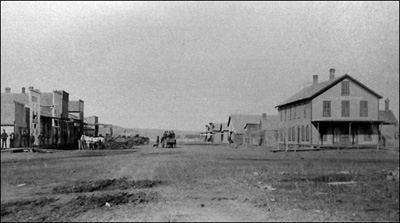 Sarah Jane died in May of 1884 when John was fourteen. We don’t know where she died, but she was buried in Indiana. This is about the time that John went to Pawnee Rock, Kansas to live with his stepfather John Stewart, who had moved there about five years earlier. Oliver Pound, Sarah Jane’s husband may have brought him there as he moved to Seward, Kansas with his family. John Stewart’s third wife died in December of the same year. Four months later, according to the Kansas census in March of 1885, John was fifteen, going to school and living with his stepfather John Stewart in Pawnee Rock. On the census, it seems to have been indicated that John Stewart had come from Illinois five years ago and John T Bullock had come from Indiana one year ago.
Sarah Jane died in May of 1884 when John was fourteen. We don’t know where she died, but she was buried in Indiana. This is about the time that John went to Pawnee Rock, Kansas to live with his stepfather John Stewart, who had moved there about five years earlier. Oliver Pound, Sarah Jane’s husband may have brought him there as he moved to Seward, Kansas with his family. John Stewart’s third wife died in December of the same year. Four months later, according to the Kansas census in March of 1885, John was fifteen, going to school and living with his stepfather John Stewart in Pawnee Rock. On the census, it seems to have been indicated that John Stewart had come from Illinois five years ago and John T Bullock had come from Indiana one year ago. 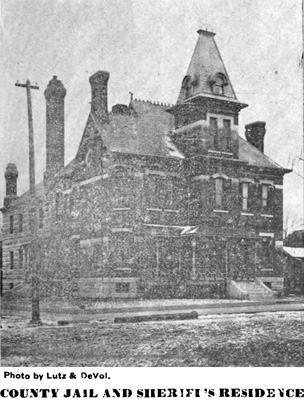 According to The Sullivan Democrat newspaper, early Sunday morning October 13, 1889 John, not yet 20, was with three of his friends, all coal miners, drinking and carousing in a shanty belonging to 75-year-old Mr. Farmer and pulling up turnips from his turnip patch. (
According to The Sullivan Democrat newspaper, early Sunday morning October 13, 1889 John, not yet 20, was with three of his friends, all coal miners, drinking and carousing in a shanty belonging to 75-year-old Mr. Farmer and pulling up turnips from his turnip patch. (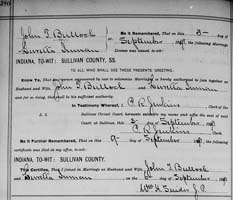
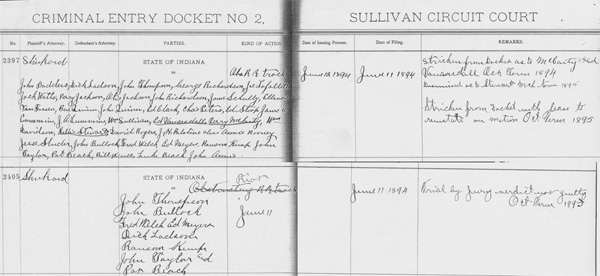
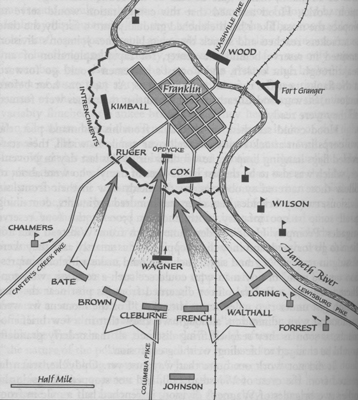
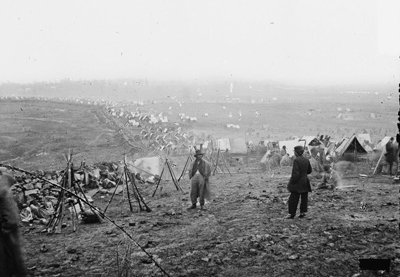 Schofield’s forces finally joined the other half of Thomas’s army and then fought Hood in the Battle of Nashville December 15-16 in what was called the most complete victory of the war. (Mouse over image left.) After helping drive Hood from Tennessee from December 17-28, the rest of the war was relatively uneventful for John P. and the Indiana 57th. They moved to Huntsville, Alabama and did duty there until March 15 - April 22 when they had operations in East Tennessee, based in Nashville until ordered to New Orleans, Louisiana on June 16. In July they were transferred to Port Lavacca, Texas doing duty at Green Lake and San Antonio. On October 10, 1865, John still a private, mustered out and went home. The war was over.
Schofield’s forces finally joined the other half of Thomas’s army and then fought Hood in the Battle of Nashville December 15-16 in what was called the most complete victory of the war. (Mouse over image left.) After helping drive Hood from Tennessee from December 17-28, the rest of the war was relatively uneventful for John P. and the Indiana 57th. They moved to Huntsville, Alabama and did duty there until March 15 - April 22 when they had operations in East Tennessee, based in Nashville until ordered to New Orleans, Louisiana on June 16. In July they were transferred to Port Lavacca, Texas doing duty at Green Lake and San Antonio. On October 10, 1865, John still a private, mustered out and went home. The war was over.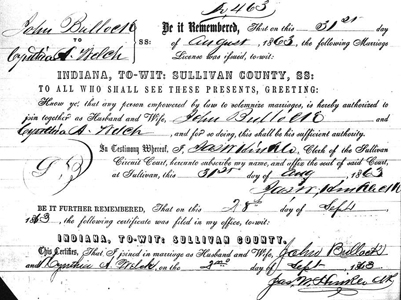 along with his wife Sarah Jane 24 and son William age 9 months. Sarah Jane was Cynthia’s older sister and the Pound family had close ties to the Welch family and also the Kester family (Rebecca Kester was Daniel’s mother).
along with his wife Sarah Jane 24 and son William age 9 months. Sarah Jane was Cynthia’s older sister and the Pound family had close ties to the Welch family and also the Kester family (Rebecca Kester was Daniel’s mother). Many Bullocks and Mayfields moved to Indiana and Illinois around this time. Susannah’s family was in Indiana by 1830. Susannah’s brother Geo was born in Kentucky about 1820, so perhaps the families met there.
Many Bullocks and Mayfields moved to Indiana and Illinois around this time. Susannah’s family was in Indiana by 1830. Susannah’s brother Geo was born in Kentucky about 1820, so perhaps the families met there.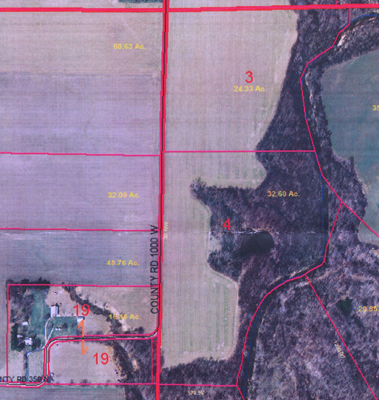 This land was described as “off the west part of the NW qr of Section Thirteen (13) Town Eight (8) North Range Eleven (11) . . . By the west bank of Turman’s Creek.” (Mouse over image left.) It was common practice in those days to purchase the land many years prior to recording the deed, so it is assumed this was the land referred to in the 1860’s Census. Unfortunately, Martin did not pay his taxes on time. Beginning on January 16, 1862 Martin’s name is listed on the Delinquent for the non-payment of Taxes list printed in the The Sullivan Democrat newspaper for more than ten years. The description of the land that taxes were due on, is the same as in the deed. The delinquent notices included this statement: “Returned as Delinquent by the Collector of Sullivan County, Indiana, for the non-payment of Taxes for the year 1861, to which are added cost, &c,, and the taxes for the year 1862.” The years changed in each notice. In the 1870’s another phrase was added to include all prior taxes -“and previous years.” At the bottom of the notice was a statement saying that the land would be auctioned off if payment wasn’t received. Apparently Martin paid his taxes late, as his land wasn’t put up for auction until 1870 (see below).
This land was described as “off the west part of the NW qr of Section Thirteen (13) Town Eight (8) North Range Eleven (11) . . . By the west bank of Turman’s Creek.” (Mouse over image left.) It was common practice in those days to purchase the land many years prior to recording the deed, so it is assumed this was the land referred to in the 1860’s Census. Unfortunately, Martin did not pay his taxes on time. Beginning on January 16, 1862 Martin’s name is listed on the Delinquent for the non-payment of Taxes list printed in the The Sullivan Democrat newspaper for more than ten years. The description of the land that taxes were due on, is the same as in the deed. The delinquent notices included this statement: “Returned as Delinquent by the Collector of Sullivan County, Indiana, for the non-payment of Taxes for the year 1861, to which are added cost, &c,, and the taxes for the year 1862.” The years changed in each notice. In the 1870’s another phrase was added to include all prior taxes -“and previous years.” At the bottom of the notice was a statement saying that the land would be auctioned off if payment wasn’t received. Apparently Martin paid his taxes late, as his land wasn’t put up for auction until 1870 (see below).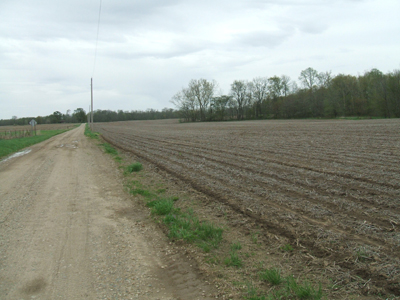 Just six months after this census, a Sheriff's Deed on Decree is dated February 4, 1871, that states the Bullock’s had one year to pay all back taxes with 10% interest and they did not pay, thus the land was sold for $700 to John Giles, a prominent man about town. This deed was brought before the Circuit Court on April 25, 1873 and was recorded with an Official Seal on May 15, 1873 at 9 o’clock am. If the Bullock’s moved or were allowed to remain in the house is unknown. It is interesting to note that Martin’s name continued to be published in the delinquent notices, after his death, for the land he lost, until February 2, 1876 for 1874 taxes. On January 23, 1878, his name is on this 1876 delinquent notice for 56 acres, but with Section 36 not 13, in the same Township 8 and Range 11. This may be a printing error or maybe Susannah moved and continued the non payment of taxes.
Just six months after this census, a Sheriff's Deed on Decree is dated February 4, 1871, that states the Bullock’s had one year to pay all back taxes with 10% interest and they did not pay, thus the land was sold for $700 to John Giles, a prominent man about town. This deed was brought before the Circuit Court on April 25, 1873 and was recorded with an Official Seal on May 15, 1873 at 9 o’clock am. If the Bullock’s moved or were allowed to remain in the house is unknown. It is interesting to note that Martin’s name continued to be published in the delinquent notices, after his death, for the land he lost, until February 2, 1876 for 1874 taxes. On January 23, 1878, his name is on this 1876 delinquent notice for 56 acres, but with Section 36 not 13, in the same Township 8 and Range 11. This may be a printing error or maybe Susannah moved and continued the non payment of taxes.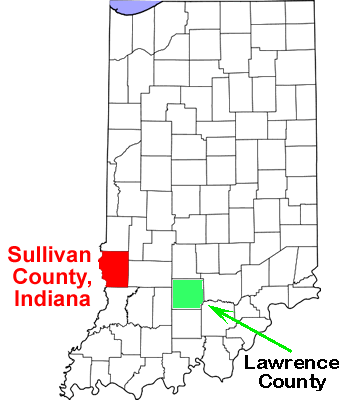 When Susannah was 17 years old, she married Martin Bullock on December 28, 1835 in Crawford County, Illinois. The license was obtained on December 27th and the next day they were married by Justice of the Peace D. Beatright. They had ten children, all born in Indiana – a son who died before 1850; ancestor John P. about 1840; Elizabeth on October 14, 1842; Mary on March 25, 1844; Chapman about 1845; Nancy about 1847; Jasper in March of 1849; Clifford about 1852; Percilla about 1853; and George L. in the summer of 1856. Of their daughters, Elizabeth married Turner Colvin (a witness in her parent’s Arson case-see below), had children and settled in Illinois; Mary was a witness in 1866 in her mother’s hog case (see below), she married Robert Anderson and again was a witness for her mother in 1867; Nancy married Theodore E. Barnes, but didn’t seem to have children and died at 29 years old; and Percilla married John Wesley Osborne and had at least one son, but died young at age 29. Of Susannah and Martin’s other sons, Chapman is not on the 1870 census and nothing more can be found about him; Jasper married Harriet Adams in 1875 in Illinois-although no children were recorded on any of their census, on the 1900 census she states she had six children but only one is still alive; Clifford married and divorced Amanda E. Daniels, they had three children, but his one son never had children; and George, who never married died on March 7, 1920 in the Sullivan County Poor House.
When Susannah was 17 years old, she married Martin Bullock on December 28, 1835 in Crawford County, Illinois. The license was obtained on December 27th and the next day they were married by Justice of the Peace D. Beatright. They had ten children, all born in Indiana – a son who died before 1850; ancestor John P. about 1840; Elizabeth on October 14, 1842; Mary on March 25, 1844; Chapman about 1845; Nancy about 1847; Jasper in March of 1849; Clifford about 1852; Percilla about 1853; and George L. in the summer of 1856. Of their daughters, Elizabeth married Turner Colvin (a witness in her parent’s Arson case-see below), had children and settled in Illinois; Mary was a witness in 1866 in her mother’s hog case (see below), she married Robert Anderson and again was a witness for her mother in 1867; Nancy married Theodore E. Barnes, but didn’t seem to have children and died at 29 years old; and Percilla married John Wesley Osborne and had at least one son, but died young at age 29. Of Susannah and Martin’s other sons, Chapman is not on the 1870 census and nothing more can be found about him; Jasper married Harriet Adams in 1875 in Illinois-although no children were recorded on any of their census, on the 1900 census she states she had six children but only one is still alive; Clifford married and divorced Amanda E. Daniels, they had three children, but his one son never had children; and George, who never married died on March 7, 1920 in the Sullivan County Poor House.
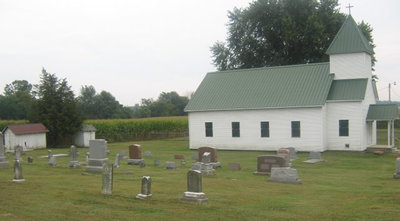 and children Sally (Sarah Jane) 14, John 12, James 9, William 6, Sintha (ancestor Cynthia) 4 and 1-year-old Alley M (Maria). Two additional children were born after the 1850 census - George, on June 7, 1854 and Charles Harmon in March of 1856. All of the children were probably born in Vigo County, except for Charles, who is believed to have been born Sullivan County. It should be noted that Daniel’s son John H. and ancestor John P. Bullock, were both drafted from Sullivan County on the same day into The Civil War. They served together in the 57th Regiment, Company F and were mustered out on the same day. John P was married to Cynthia, John H’s sister. They must have become close, as they both settled in Illinois after the war.
and children Sally (Sarah Jane) 14, John 12, James 9, William 6, Sintha (ancestor Cynthia) 4 and 1-year-old Alley M (Maria). Two additional children were born after the 1850 census - George, on June 7, 1854 and Charles Harmon in March of 1856. All of the children were probably born in Vigo County, except for Charles, who is believed to have been born Sullivan County. It should be noted that Daniel’s son John H. and ancestor John P. Bullock, were both drafted from Sullivan County on the same day into The Civil War. They served together in the 57th Regiment, Company F and were mustered out on the same day. John P was married to Cynthia, John H’s sister. They must have become close, as they both settled in Illinois after the war.
 William’s wife must have died, because on July 27, 1808 in Winchester, he married Elizabeth Myers, who was much younger than him (mouse over image above). In the Marriage Bonds of Clark County, Kentucky collection, it states that she “ . . . gives her own consent in writing . . . Benjamin Whayne and Nancy Whayne, his wife, made oath that Elizabeth Myers is upwards of twenty-one years of age.” This seems to mean that her parents were probably deceased and that she must have been in her early twenties. On the 1810 United States Federal Census for Clark County, Kentucky, William is listed as 45 and over and the only female listed is 26 thru 44. Nothing more is known about Elizabeth except that William called her Betsy in his will.
William’s wife must have died, because on July 27, 1808 in Winchester, he married Elizabeth Myers, who was much younger than him (mouse over image above). In the Marriage Bonds of Clark County, Kentucky collection, it states that she “ . . . gives her own consent in writing . . . Benjamin Whayne and Nancy Whayne, his wife, made oath that Elizabeth Myers is upwards of twenty-one years of age.” This seems to mean that her parents were probably deceased and that she must have been in her early twenties. On the 1810 United States Federal Census for Clark County, Kentucky, William is listed as 45 and over and the only female listed is 26 thru 44. Nothing more is known about Elizabeth except that William called her Betsy in his will.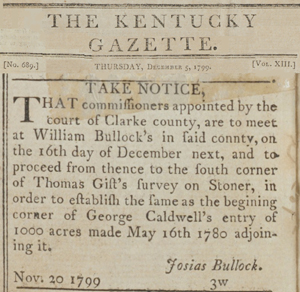 William Bullock’s name is listed on the tax records for 1794 and 95; 1797; there wasn’t a 1798 tax book; and then for each year from 1799 until 1813. In these records we find that he began with 200 Acres of Land, 2nd Quality, 6 Blacks, 4 Horses, and 8 Cattle that was originally patented to George Caldwell, located in the Donaldson Watercourse. On August 27, 1799 he has 25 fewer acres and his son John P. is recorded as being over 16 years-old. From November 21st thru December 5th of that same year, a notice dated November 20, 1799, was published in the Kentucky Gazette, which may explain the loss in acreage. It states that the commissioners “appointed by the court of Clarke county, are to meet at William Bullock's in said connty, [county] on the 16th day of December next, and to proceed from thence to the fouth [south] corner of Thomas Gift’s furyey [survey] on Stoner, in order to eftablifh [establish] the fame as the begining [beginning] corner of George Caldwell’s entry of 1000 acres made May 16th 1780 adjoining it.” (Mouse over image left for repository.) Apparently, they measured his land to be only 175 acres, although he thought he purchased 200 acres. His land is recorded at 175 acres for the next few years, and in 1801, the watercourse is officially called Stoner. In 1805 his 2nd rate acreage is 399. The next year it’s back down to 375 acres, then the following year, 1807 it’s down to 330 acres.
William Bullock’s name is listed on the tax records for 1794 and 95; 1797; there wasn’t a 1798 tax book; and then for each year from 1799 until 1813. In these records we find that he began with 200 Acres of Land, 2nd Quality, 6 Blacks, 4 Horses, and 8 Cattle that was originally patented to George Caldwell, located in the Donaldson Watercourse. On August 27, 1799 he has 25 fewer acres and his son John P. is recorded as being over 16 years-old. From November 21st thru December 5th of that same year, a notice dated November 20, 1799, was published in the Kentucky Gazette, which may explain the loss in acreage. It states that the commissioners “appointed by the court of Clarke county, are to meet at William Bullock's in said connty, [county] on the 16th day of December next, and to proceed from thence to the fouth [south] corner of Thomas Gift’s furyey [survey] on Stoner, in order to eftablifh [establish] the fame as the begining [beginning] corner of George Caldwell’s entry of 1000 acres made May 16th 1780 adjoining it.” (Mouse over image left for repository.) Apparently, they measured his land to be only 175 acres, although he thought he purchased 200 acres. His land is recorded at 175 acres for the next few years, and in 1801, the watercourse is officially called Stoner. In 1805 his 2nd rate acreage is 399. The next year it’s back down to 375 acres, then the following year, 1807 it’s down to 330 acres. 